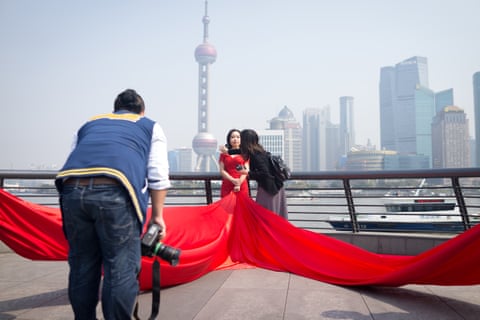The photographer and his crew sit outside the tank, grinning.
“Beauty, how long can you hold your breath under water?” one calls out to the sopping wet woman in the wedding gown. A moment later, he addresses the groom-to-be: “Handsome, when you dive down, just suck your tummy in a bit. Your bum as well.”
It’s not the most romantic scenario but the end results – post-Photoshop – are stunning. As is a custom in modern-day China, events manager Jenny Cheng and banker David Shaw have shelled out for pre-wedding photos, which can be as ambitious as they are expensive – up to $AU250,000 if shot in exotic destinations such as Paris, Bali or Sydney.
A behind-the-scenes image and a Photoshopped final image of David and Jenny.
Jenny can’t swim, so she’s been anxiously practising holding hands underwater with David in swimming pools. David, an Australian, finds the whole procedure “fake” but is far more amenable than some of the mates who attend his eventual wedding six months later.

Only Photo is a pre-wedding photography studio in an industrial park just out of Shanghai, with three floors of ‘old world’ romantic and fantasy sets.
That’s according to Olivia Martin-McGuire, an Australian photographer who became intrigued by China’s billion-dollar pre-wedding photography industry while living in Shanghai for four years. Her film debut, China Love, is an empathetic take on how the country’s tumultuous history since the Cultural Revolution has influenced its present day.
“The pre-wedding industry is a moment in time … it’s this real fantasy moment where you are capturing a country dreaming,” she says. The backdrop to many photos may mimic a western setting, for instance, but 90% of Chinese people don’t have passports. “I don’t think it’s going to be like this in 15 years.”
In the film, couples who had state-arranged marriages during the country’s Communist party rule show the black-and-white wedding photos they had taken: more like ID cards, with the subjects still in their work uniforms. Wedding gifts back then tended to be literature by Chairman Mao.
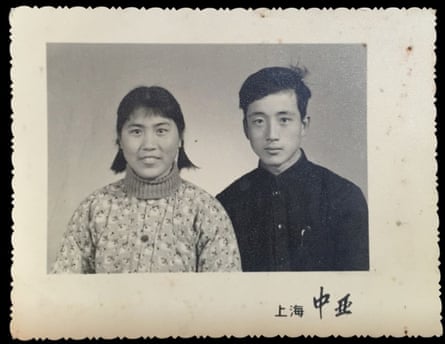
Clockwise from top: The original wedding photo of Pei Pei and Sun, and behind the scenes of their new wedding shoot.

“They didn’t have any access to the rest of the world, and then to have the next generation in this futuristic state of possibilities, where China is booming and becoming a world power – you have such a tension between those two generations,” Martin-McGuire says. “In other countries you have the past, the present and the future. But in China, you really just have the future and the past rubbing up against each other.”

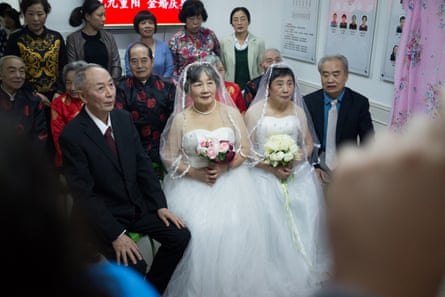
A pre-wedding shoot for those who were denied wedding photos before the cultural revolution
Martin-McGuire follows some couples in their 80s and 90s, who are treated by a charity to belated pre-wedding photos as part of a project called Frame the Vow. These new photoshoots, which revolve around pampering and celebrating 60-odd years of love, are a way to heal from the trauma of growing up in Communist China.
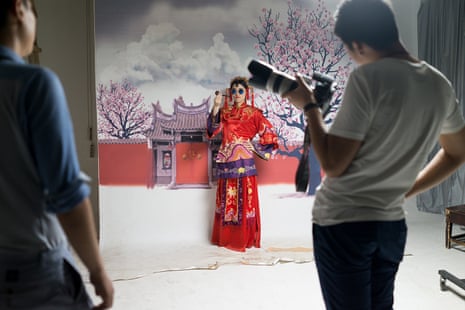
A bride-to-be poses inside the Only Photo studio.
William Fong is a marketing manager and Viona Ma was an HR headhunter before getting pregnant. The Shanghai couple features in China Love, and opted for a shoot that cost about $1,600-$1,800 – although that rose to $3,000 once the add-ons were included, such as dress upgrades and the rental of a designer wedding dress.
Fong tells Guardian Australia he’d call the flavour of the shoot “Korean drama/fantasy, which is heavily inspired by an old European aesthetic. The style and scenes are very much in line with the over-the-top portrayal of a Korean dreamy love story.”
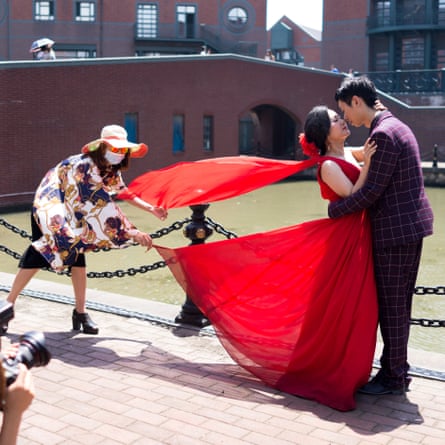

Just outside of Shanghai, Thames Town is a themed village modelled on England, whose main use is now as a wedding photo location.
In the film, Ma is depicted as being under pressure to marry and then have children, despite enjoying independence and a successful career – but Fong says the reality of their situation is more nuanced.
“Life [in China] can be equally as hard on men with the expectations for the groom’s side of the family to provide security to the bride, such as an apartment they can call home,” he says. “People in Australia would criticise that this mentality sounds very shallow; many do not realise that their critique comes from a perspective that is relatively safe, [with] safety nets provided by the government and NGOs, which is not the case in China. I don’t think I’ve even seen a soup kitchen here before.”

A couple in between takes.
Tracey Lin is the founder of TL Wedding in Sydney, whose clients come from a Chinese background. She estimates half are local and half – about 200 couples – fly over for shoots with backdrops such as the Opera House or St Mary’s Cathedral. The majority have made the arrangements through agents, she says, because the Chinese government restricts access to Google and Facebook.



Lin tells Guardian Australia that the tradition of pre-wedding shoots began around 50 years ago but has become turbocharged in the last decade. There’s now so much competition, she says, that each company tries to outdo the others.
She herself had a pre-wedding shoot in China about 10 years ago. “The studio wasn’t as big as what we see now and the backdrop wasn’t as good – it was like an ordinary paper background and then you get the beach Photoshopped on,” she laughs. “I spent around $5,000. I would have preferred something outdoors – but, because of the pollution, the outdoor locations aren’t as good as Sydney.”

